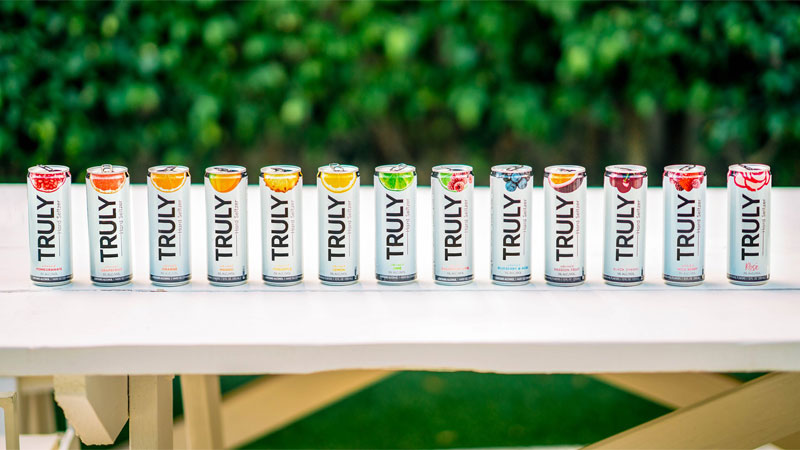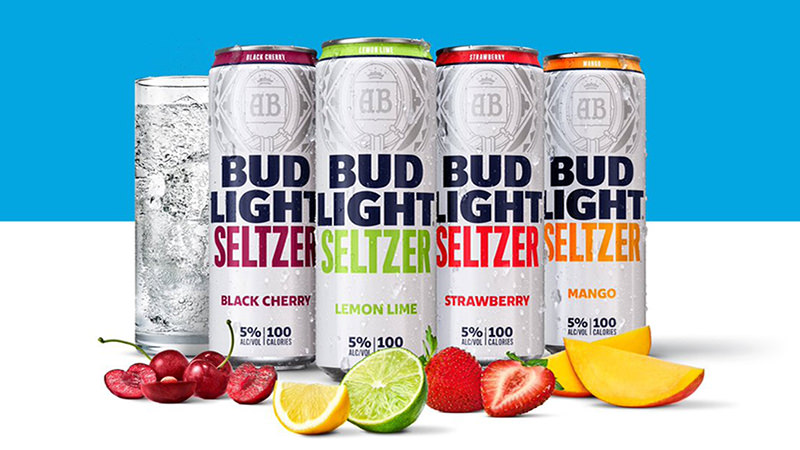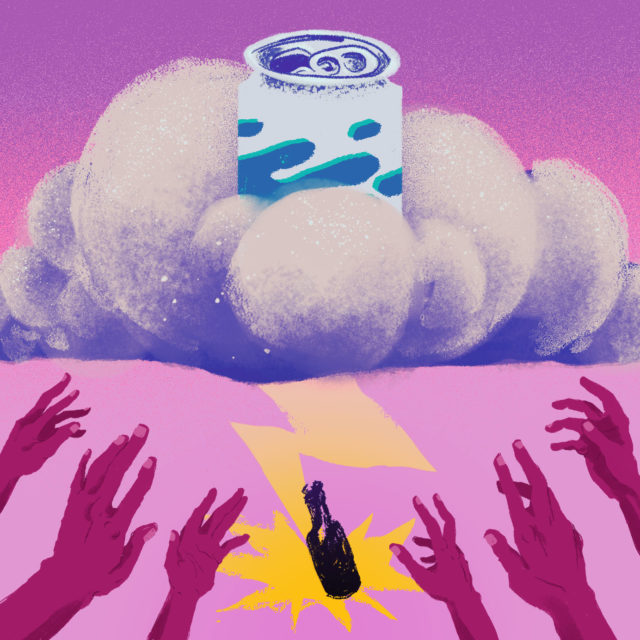Any doubts over whether hard seltzer was just a “fad” were put to bed after last year’s sales figures came out: In 2019, U.S. drinkers bought more hard seltzer by volume than vodka. To be exact, we purchased 82.5 million 9-liter cases, or almost 2.1 billion 355-milliliter cans, according to global data firm IWSR.
In the last 12 months, hard seltzer’s total share of the overall alcohol market in sales by volume rose to 2.6 percent — a small figure until you consider it’s more than a third of the total volume sales of all spirits, which stands at 6.8 percent. It’s even creeping in on wine’s 11 percent. Hard seltzer is barely five years old.
VinePair’s own internal data confirms that consumers are deeply interested in the category. Per VinePair Audience Insights, consumer interest in hard seltzer was up an incredible 992 percent year-over-year across the 65 types of wine, beer, and spirits tracked. It finished 2019 as the single most popular type of “beer.”
Although it is, at this point, impossible to deny the category’s short-term staying power, its unprecedented popularity and sales raise bigger questions about spiked sparkling water. Namely: How the hell did we get here so fast? And how, if at all, can hard seltzer sustain its epic growth?
What Are Hard Seltzers?
Technically known as flavored malt beverages (FMBs), hard seltzers gain their alcoholic kick via the fermentation of malted grains or, in most cases, cane sugars. Previous hits in the FMB back catalog include brands like Zima and Smirnoff Ice — drinks that had their day in the sun in the 1990s and early 2000s, respectively, then faded like a worn Hawaiian shirt.
(There was also the once-hotly-tipped hard soda category, which ultimately failed to make a splash — no one needs a father-defying alcoholic root beer.)
What hard seltzers have that other FMBs don’t is their unbeatable wellness-culture-friendly nutritional values.
Hard seltzers offer drinkers an alcohol option with low calories (100 or fewer per 12-ounce serving), little to no sugar (1 gram or less), and barely there carbs (1 to 2 grams). They arrive in convenient 12-ounce servings, and their flavor profiles are light and refreshing, often resembling flavored non-alcoholic seltzers like La Croix and, in more “craft”-like cases, Spindrift.
The First Wave of Hard Seltzers
Although data varies slightly by market analyst, at the end of 2019, three hard seltzer brands enjoyed between 80 and 90 percent of the category’s sales: White Claw, Truly, and Bon & Viv.
White Claw leads the pack by a distance and currently holds a 50 percent share of the hard seltzer market, according to Nielsen data. Launched in 2016 by Mark Anthony Brands, the parent company of Mike’s Hard Lemonade (another early FMB), the brand shot to fame during the “White Claw Summer” of 2019, after its proliferation on social media platforms typically favored by millennial audiences. A highlights reel from the year might include a slew of internet memes, parody YouTube videos, and impossible-to-get-out-of-your-head phrases like “Ain’t no laws when you’re drinking claws.”
White Claw’s viral appeal is reflected in sales. On e-commerce platform Drizly, millennials and gen x’ers drove year-to-date growth of White Claw 577 percent, according to the company’s head of consumer insights, Liz Paquette.
Sales were so strong last summer that Mark Anthony Brands declared a nationwide shortage. (White Claw fans came up with their own term for the situation, declaring depleted retailers as being “declawed.”) Mark Anthony Brands is preventing a repeated catastrophe by constructing a 916,000-square-foot production facility in Glendale, Ariz., which is set to begin operations in June 2020.

Truly Hard Seltzer (formerly Truly Spiked and Sparkling), launched by Boston Beer in 2016, currently holds 22 percent market share, helping boost the share value of its parent company by as much as 45 percent in 2019.
“Over the past few years, Truly Hard Seltzer has really been pivotal for Boston Beer,” Casey O’Neill, the company’s product development manager, tells VinePair.
In 2019, Truly became the first brand to take hard seltzer airborne after signing an exclusive partnership with JetBlue. It also became the first hard seltzer available nationwide on draft. This January, Truly launched a hard seltzer lemonade, targeting those who enjoy the flavor of lemonade but don’t like the sweetness (or calories) that come with it.
(O’Neill denied the fact that Boston Beer launched the product as a direct rival to Mark Anthony Brands’ Mike’s Hard Seltzer, but we’ll agree to disagree.)
That leaves Bon & Viv Spiked Seltzer the third and final “top-three” brand — now the least significant in terms of sales, but a pivotal player in the category.
Originally launched as SpikedSeltzer by Connecticut-based beverage entrepreneur Nick Shields in 2013, the brand was the first widely available commercial hard seltzer. When numerous imitator brands launched, the evolving category became synonymous with Shields’ pioneering brand, with drinkers commonly referring to the beverages as “spiked seltzers.” (It wasn’t until 2019 that the category overwhelmingly became known as hard seltzer.)
Anheuser-Busch InBev (AB InBev) acquired SpikedSeltzer in 2016 and enacted a complete rebrand, debuting the new “Bon & Viv Spiked Seltzer” in a flashy, conceptual Super Bowl ad in 2019.
Even with its head start — and the backing of a multi-billion-dollar beer conglomerate — Bon & Viv now accounts for less than 10-percent of hard seltzer sales. In a few short years, it has essentially become the MySpace of the hard seltzer category.
Behemoths Enter the Race
Hard seltzers dominated alcohol sales in summer 2019. The category is predicted to exceed $2.5 billion in sales by the end of 2021. Naturally, large alcohol brands are forced to take action or risk being left behind for good.
Come fall, in October 2019, Constellation Brands announced it was planning to launch Corona Hard Seltzer. To make up for lost ground, Constellation budgeted $40 million for the marketing alone. MillerCoors also aimed for an early-2020 launch of its own hard seltzer, Vizzy, targeting health-conscious consumers by focusing its messaging around the product’s high levels of vitamin C. (MillerCoors is currently entangled in a lawsuit filed by the previously existing hard seltzer brand, Brizzy.)
Meanwhile, AB InBev added two big-name hard seltzer brands to its lineup — Natural Light Seltzer in August 2019, and Bud Light Seltzer in January 2020. The latter is already making waves: According to IRI data, Bud Light Seltzer was the third most popular hard seltzer during the week leading up to the Super Bowl, registering $4.9 million in sales. And that was before the Post Malone ads.

Other big-name beverage brands rushing to get in on the action include E. & J. Gallo, the world’s largest family-owned winery, which has an estimated $5 billion in revenues. In January 2020, it announced it was launching the world’s first wine-based hard seltzer through its Barefoot brand.
The product follows a familiar formula: Each 250-milliliter gluten-free serving has 70 calories, 2 grams of sugar, and 4 percent ABV.
“Our consumers enjoy wine-based products and they are always looking for new tastes, formats and packaging that they can enjoy in new places or for new occasions,” Anna Bell, Barefoot’s vice president of marketing, writes VinePair in an email. “We are very confident in the hard seltzer category [and] believe [it] will continue to grow into the foreseeable future.”
E. & J. Gallo also offers another spin on the category through its High Noon brand, currently the only so-called hard seltzer made with vodka, rather than fermented cane sugar, malt, or wine.
Beer & Hard Seltzer: Frenemies
Despite its success in dollar signs, industry professionals remain divided on where hard seltzer’s incredible growth is coming from.
Speaking to Forbes in 2019, Sanjiv Gajiwala, vice president of marketing at Mark Anthony Brands, said 55 percent of White Claw’s volume sales came from beer consumers, while 20 percent came from wine, and 17 percent from spirits. The remaining 8 percent came from a mix of other categories, including cider and other FMBs, he said.
Brewers Association chief economist Bart Watson disagrees. In a 2019 report he authored, using sales data from research firm IRI, Watson claimed just 27 percent of hard seltzer volume was coming from beer. “My general take was that the consumers for hard seltzer don’t overlap with the classic craft beer consumer that much,” he says, noting that the light, easy-drinking hard seltzer category is far removed from the big, bold flavors typically offered by craft beer brands.
Hard seltzer is affecting the craft beer market in other ways, though. The Brewers Association’s most recent update to the “craft” definition shifted the goalposts for brewers. Previously, 50 percent or more of their production volume had to be brewed using “traditional or innovative brewing ingredients” (think: malted barley), and basically resemble something consumers would traditionally think of as beer.
Now, they only have to include beer in their portfolios and are free to make as much wine, liquor, hard kombucha, or hard seltzer as they want.
Watson agrees that hard seltzer offers a business opportunity for craft brewers that want to diversify, but stops short of predicting the category is here to stay. “It remains to be seen how much the seltzer market is actually a segment and a category, versus a couple of very powerful brands,” he says.
Craft Seltzer Boom?
For others, the future is clear, bubbly, and a little bit boozy.
“White Claw and Truly are always going to be massive,” Nico Enriquez, founder of Willie’s Superbrew, an independent hard seltzer maker based in Charlestown, Mass., says. But he believes that just as a very small number of large-scale brands dominate the beer market, craft hard seltzer brands can capitalize on the remaining market share. “We expect the category to mature very quickly and people will soon start trading up towards premium drinks,” he says.
While brands like White Claw and Truly create their products using “natural” flavorings, Willie’s uses fresh ingredients (fruits and spices) during fermentation. The advantage, he says, is improved and more depth of flavor, and a visually attractive beverage that has naturally occurring color (most hard seltzers are clear).
If and when consumers decide to trade up, Willie’s is poised to meet that demand. Enriquez and his team have spent the past four and a half years developing a production process that can be scaled up without compromising consistency or quality — two hurdles that have traditionally plagued craft beer brands, he says.
Enriquez also predicts the hard seltzer market will soon become more fragmented and specialized, much like craft beer did, and says nutritional values are the only constraints within the space.
“Whether it’s barrel aging, or blending in some crazy peppers, or doing something that has a benefit for an animal rights shelter, all of the playbooks you’ve seen in craft beer are going to be replayed in seltzer,” he says.
Learning lessons from the beer industry, especially with its close ties to the category, seems like a shrewd business move, though exactly how far away we are from Bourbon County Black Cherry remains to be seen.
In the meantime, 2020 should at least answer a few burning questions: Will hard seltzer sales continue to grow at such a staggering rate? (Probably.) Can Bud Light Seltzer declaw retailers of today’s leading brand? (Maybe.) And will Bon & Viv remain in anyone’s “Top Eight” list come December? (Who?)
One thing’s for sure: Only a fool would ignore their local weathercaster’s predictions of a long, hot, White Claw summer.
